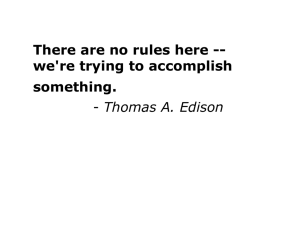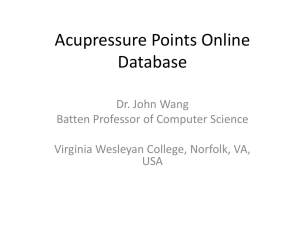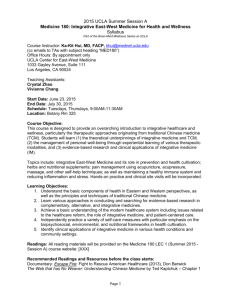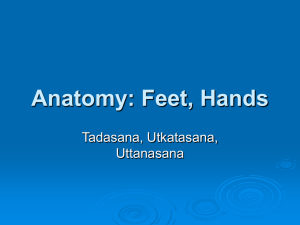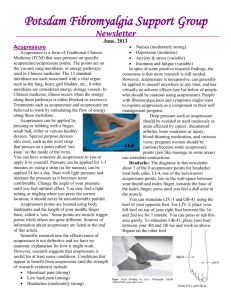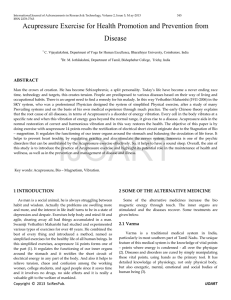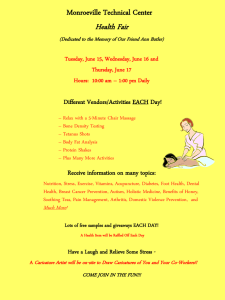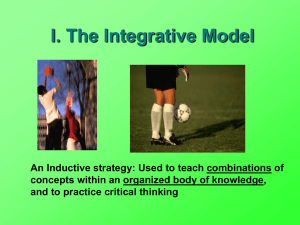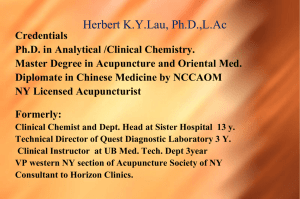the presentation
advertisement
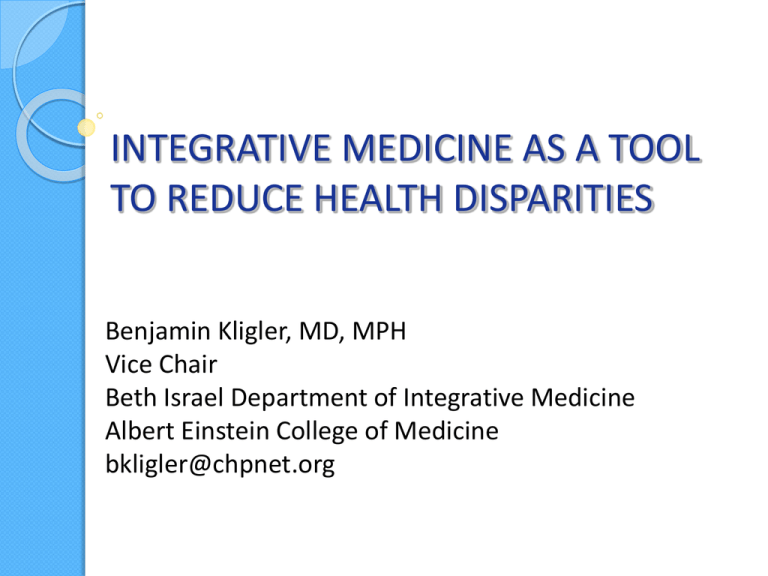
INTEGRATIVE MEDICINE AS A TOOL TO REDUCE HEALTH DISPARITIES Benjamin Kligler, MD, MPH Vice Chair Beth Israel Department of Integrative Medicine Albert Einstein College of Medicine bkligler@chpnet.org OBJECTIVES Discuss four examples of programs for underserved populations using differing successful strategies Provide examples of tools that an individual practitioner working in an underserved setting can used effectively with patients ◦ Mind/body techniques ◦ Acupressure ◦ Herbal medicine FOUR EXAMPLES Lawrence Family Health Center Group Programs (Massachusetts) Venice Health Center (California) NYC-RING Albert Einstein Practicebased Research Network (New York) Wellness in the Schools (New York) Thanks to Jeff Geller (Lawrence), Myles Spar (Venice), and Nancy Easton (WITS), and to all of their funders! EXAMPLE #1: GREATER LAWRENCE FAMILY HEALTH CENTER GROUP VISITS: EMPOWERING THE PATIENT WHILE REDUCING COSTS Lawrence, MA ◦ Poorest city in state ◦ Predominantly Latino (est. 70%) Greater Lawrence Family Health Center ◦ Lawrence Family Practice Residency / HIP fellowship 38 weekly group visits: 9 providers, 1-3 fellows In addition to obesity: prenatal, chronic pain, smoking cessation, asthma, buprenorphone, diabetes, heart disease, homeless clinic, acupuncture…. Focus on support / loneliness and stress reduction The Setting 2 types of group visit models Open ended Models ◦ ◦ ◦ ◦ ◦ No end date Rolling admission No predetermined specific goals Predetermined population / illness Open access appointments Enclosed Models ◦ Specific curriculum ◦ Certain number of meetings or classes ◦ Often specific predetermined goals / population / illness ◦ More scheduled appointments, known participants. 2 types of group visit models • Open ended Models – Cardiac disease: HTN, High Cholesterol, DM – Weight loss – Smoking cessation – Stress related illness – Chronic pain – Developmental delay – Pediatric Obesity 14 6 4 1 1 3 2 • 3 Family, 1 Toddler, 9 Children 8-12yo, 1 children 13-18yo • Enclosed Models – Acupuncture (6 spaces) – Prenatal – Suboxone 2 – Diabetes self management and education 2 1 2 “The exercises aren’t just great for losing weight, but they also relax the mind; the program helps me make new friends …and we treat each other like family. When someone doesn’t come on a particular day, we are already missing each other! These exercise groups are a complete therapy.” EXAMPLE #2: VENICE FAMILY CLINIC/ALBERT EINSTEIN PRACTICE-BASED RESEARCH NETWORK INCREASING ACCESS BY BRINGING COMPLEMENTARY/ALTERNATIVE MEDICINE TRAINEES TO THE COMMUNITY SETTING Venice Family Clinic Provides primary care & selected specialty care to 24,413 patients in 9 locations over west side of Los Angeles Over 106,000 visits per year Mainly minority patients (81%) & without health insurance (78%) Racially mixed clientele but predominantly Hispanic (63%) Multidisciplinary Chronic Pain Program Conditions Modalities ◦ All chronic, painful M/S conditions w & w/o injuries ◦ Especially back, neck and shoulder conditions ◦ Not soliciting referrals for neuropathy & other treatment resistant conditions initially ◦ ◦ ◦ ◦ ◦ ◦ ◦ Conventional medicine Traditional Chinese Medicine (Acupuncture) Osteopathy Chiropractic Massage Physical Therapy Social Work/ Mental Health Education of Staff, Providers & Patients Program to Date Started March 1, 2006 2,911 patients have been seen (as of June 30, 2011) Currently there is a waitlist for all modalities Patient Demographics ◦ Average age 49 (22-73) ◦ Gender: M 36%; F 64% Education: ◦ 4% Graduate or professional degree ◦ 17% College degree ◦ 25% Education beyond high school ◦ 25% High School or equiv ◦ 29% no h.s diploma Household Income ◦ 10% $20,000-$50,000 ◦ 89% less than $20,000 Insurance Status ◦ 4% Medi-Cal ◦ 5% Medicare ◦ 91% no insurance Outcomes tables Brief Pain Inventory- Severity Scale mean comment score Pre-treatment BPI Post-Treatment BPI 23.94 19.74 Significant improvement in severity of pain from pre-treatment to post-treatment at P<0.05. Follow-up BPI 17.79 Significant improvement in severity of pain continued to be reported at follow-up at P<0.05 (for the difference from pre-treatment to follow-up). ADDOPT: ACUPUNCTURE TO DECREASE DISPARITIES IN PAIN TREATMENT NIH/NCCAM-funded trial, testing acupuncture as an adjunct to usual treatment for chronic pain in four urban health centers. These health centers belong to New York City Research and Improvement Networking Group (NYC RING), a practice-based research network dedicated to decreasing health disparities through primary care research and quality improvement in the urban safety net setting. METHODS Population: primary care patients (>18 years) with chronic pain due to osteoarthritis, neck or back pain at four hospital owned safety net community health centers in the Bronx NY. The patient population was ethnically diverse and low income in a medically underserved area of the Bronx. Intervention: weekly acupuncture treatments for up to 14 weeks. The acupuncture team was free to adapt and change the treatment approach from week to week based on the condition of the patient and response to treatment. RESULTS 226 patients completed the trial Average age was 54; 60% were Medicaid insured and 38% on disability; high baseline levels of pain (mean BPI pain severity 6.8; mean days with pain, 12.3 of 14 days ). Mean number of treatments was 8.0 (SD 4.7). Reduction in pain severity between baseline and treatment phase was significant (p <.001). Improvements in physical well-being were significant at 12 and 24 weeks post-baseline (p <.001). 30.3% experienced a 30% or greater improvement in pain—the generally accepted threshold for clinically significant change. EXAMPLE #3: WELLNESS IN THE SCHOOLS BRINGING NEW KNOWLEDGE AND SKILLS FOR GREATER HEALTH INTO THE SCHOOLS! WELLNESS IN THE SCHOOLS $167 billion per year on obesity-related illness 43% of children in NY are obese 30,000 kids in 36 under-resourced schools Cook for Kids: uses culinary interns to bring fresh and health food to schools Coach for Kids: stations coaches in recess yards to encourage physical activity Green for Kids: environmentally safe cleaning products for schools ACUPRESSURE FOR NAUSEA: The Evidence randomized, placebo-controlled, pilot study of acupressure at the Neiguan point (P6) for NVP involving 60 women. RESULTS: It is possible to reduce NVP significantly with acupressure at P6 as compared to acupressure at a placebo point or no treatment at all in healthy women with normal pregnancies. Relief from nausea appeared one day after starting treatment in both the P6 and placebo groups but lasted for only six days in the placebo group. The P6 group, however, experienced significantly less nausea after 14 days as compared to the other two groups. Werntoft, E. Dykes, A K Effect of acupressure on nausea and vomiting during pregnancy. A randomized, placebo-controlled, pilot study.Journal of Reproductive Medicine. 46(9):835-9, 2001 ACUPRESSURE FOR LOW BACK PAIN: The Evidence Randomized controlled trial of 129 patients with chronic low back pain. Acupressure or physical therapy for one month. RESULTS: The mean total Roland and Morris disability questionnaire score after treatment was significantly lower in the acupressure group than in the physical therapy group regardless of the difference in absolute score (3.8, 95% confidence interval - 5.7 to - 1.9) or mean change from the baseline (- 4.64, - 6.39 to - 2.89). Acupressure conferred an 89% (95% confidence interval 61% to 97%) reduction in significant disability compared with physical therapy. The improvement in disability score in the acupressure group compared with the physical group remained at six month follow-up. Statistically significant differences also occurred between the two groups for all six domains of the core outcome, pain visual scale, and modified Oswestry disability questionnaire after treatment and at six month follow-up. Hsieh LL. Kuo CH. Lee LH. Yen AM. Chien KL. Chen TH.Treatment of low back pain by acupressure and physical therapy: randomised controlled trial.BMJ. 332(7543):696-700, 2006 Techniques Which Can Elicit the Relaxation Response Diaphragmatic Breathing Meditation Body Scan Mindfulness Repetitive exercise Repetitive prayer Progressive muscle relaxation Yoga Stretching Imagery (Music) What can you teach in a 15-minute office visit? Exercise vs. SSRI for Depression Observed mean depression scores before and after treatment Blumenthal, J. A. et al. Arch Intern Med 1999;159:2349-2356. Copyright restrictions may apply. HERBAL MEDICINES Pros and cons of using infusions/teas vs. standardized extracts Specific conditions and applications ◦ Irritable bowel syndrome ◦ Upper respiratory infection ◦ insomnia Organic Licorice Root, Organic Cardamom Seed, Organic Fennel Seed, Organic Coriander Seed, Organic Barley Malt, Organic Peppermint Leaf, Organic Ginger Root, Organic Black Pepper. RESOURCES:TEACHING MATERIALS http://uwhealth.org/alternativemedicine/breathing-exercises/30408 http://fammed.wisc.edu/integrative/mod ules Integrative Medicine for the Underserved http://im4us.org/HomePage Clinicians’ and Educators’ Desk Reference on the Licensed Complementary and Alternative Healthcare Professions http://accahc.org/cedr RESOURCES: ORGANIZATIONS Consortium of Academic Health Centers for Integrative Medicine http://imconsort.org Academic Consortium of Complementary and Alternative Healthcare (ACCAHC) http://accahc.org Center Institute for Research and Education in Integrative Medicine http://healthandhealingny.org/Institute Clinicians’ and Educators’ Desk Reference on the Licensed Complementary and Alternative Healthcare Professions Focus on the 5 licensed integrative health and medicine disciplines ◦ Chiropractic, acupuncture and Oriental Medicine, naturopathic medicine, massage therapy, direct entry midwifery ◦ All with US Department of Educationrecognized accrediting agencies ◦ Plus, 6 related fields All ◦ to a template with 18 fields Accreditation, licensing, scope, research, integration, etc. More Info: accahc.org/cedr David Eisenberg, MD Harvard School of Public Health “This information will be very useful to patients, healthcare professionals, educators, students and those responsible for future clinical research and healthcare policy.”
